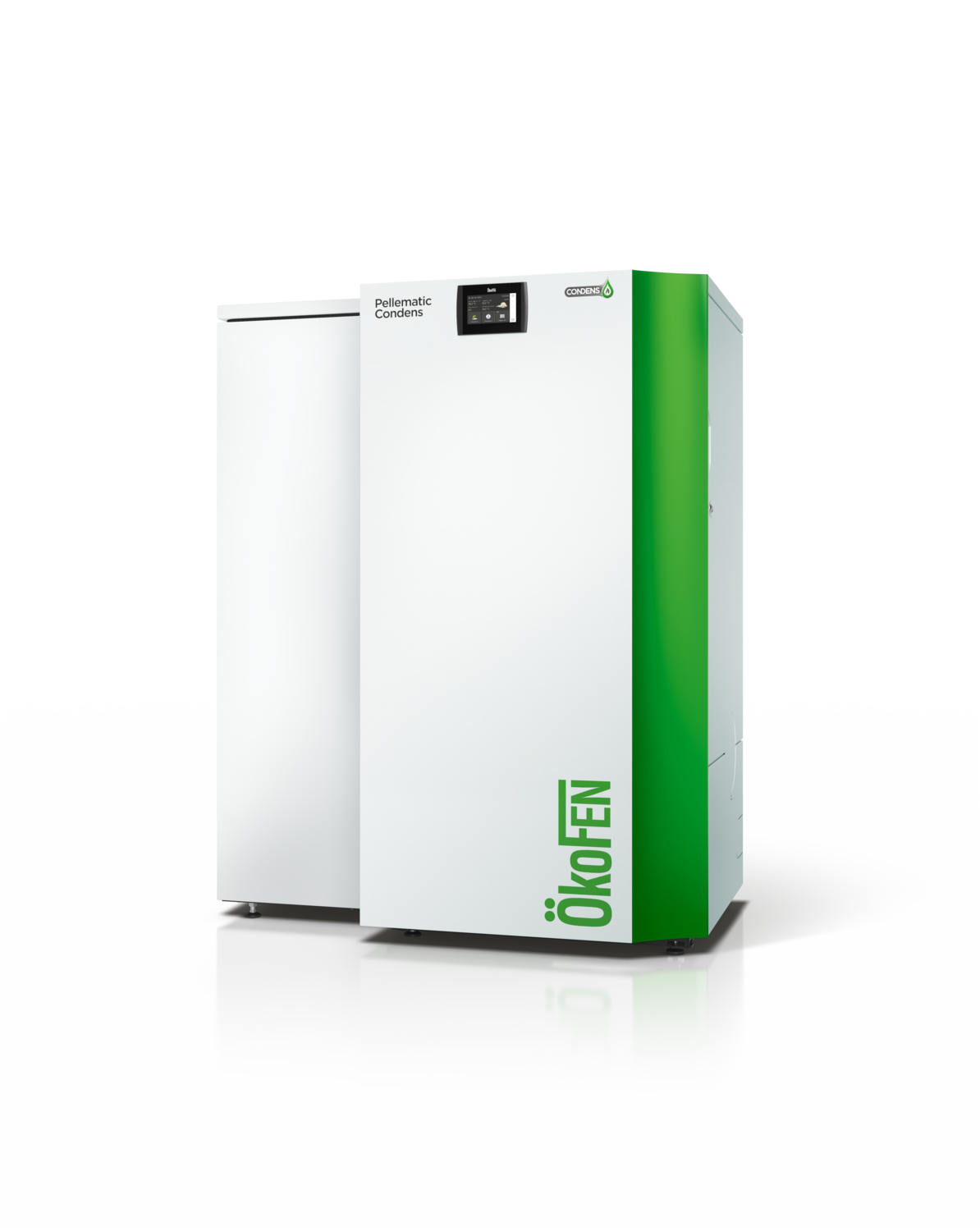What is condensing technology?
Highly efficient heating
ÖkoFEN pellet boilers with condensing technology utilize the energy content of pellets almost completely. The additional heat recovery from the residual heat contained in the water vapor achieves an efficiency gain of around 15%. Compared to a standard boiler without condensing technology, dust emissions can also be reduced by up to 50%.
This not only reduces heating costs, but also protects the climate in the best possible way.
How condensing technology works
When pellets are burned, water is produced in the flue gas in the form of steam. This normally escapes unused via the chimney.
Condensing technology, on the other hand, makes use of precisely this flue gas. The flue gas is cooled down to below the condensation temperature with this water vapor. The liquid condensate that is produced releases a lot of heat during the conversion process.
This is additional heat that can be fed back in and used. This additional energy gain increases efficiency by up to 15%.
How a heating system with condensing boiler technology works

Advantages of condensing boiler technology
Condensing technology uses the residual heat contained in the exhaust gases: the water vapor is cooled below the condensation temperature. The resulting liquid condensate releases heat. This means that the exhaust air loss and consequently the energy requirement are lower. As a result, condensing technology can achieve efficiency gains of up to 15%, while at the same time saving you this amount on fuel consumption.
The emissions from ÖkoFEN pellet heating systems have long been well below the legal limits. Thanks to condensing technology, however, the exhaust air produced when burning pellets is also naturally cleaned before it escapes through the chimney. As a result, pellet boilers with condensing technology achieve an additional reduction in dust emissions of up to 90% compared to standard boilers without condensing technology.
Highlights of condensing boiler technology
Requirements for the installation of a condensing boiler
In order to be able to use a condensing boiler, you should ensure in advance that the necessary requirements for installation are met:
![]() a corrosion-resistant chimney (stainless steel or ceramic)
a corrosion-resistant chimney (stainless steel or ceramic)
![]() Return temperatures of max. 40 °C
Return temperatures of max. 40 °C
![]() Duct connection for condensate drainage from the boiler
Duct connection for condensate drainage from the boiler
Other terms
Heating systems with condensing technology utilise almost all the energy contained in the exhaust gases from pellets. This additional benefit of approx. 16.3% with pellets is simultaneously the energy saving made possible by condensing technology. This saves money. This allows condensing boilers like the Pellematic Condens to achieve efficiency levels of up to 107.3%*.
Condensing technology subjects the flue gas quite naturally to additional cleaning – emission levels are therefore significantly lower than the legal limits. Pellet boilers with condensing technology achieve a reduction in dust emissions of 40–50% compared to standard boilers without condensing technology. Modern pellet boilers are therefore not comparable in any way with old wood boilers either as regards emissions. So a condensing boiler helps not only to reduce energy costs, but also to protect the climate.
Due to their high efficiency with lowest emission levels, pellet condensing boilers also qualify for particularly attractive subsidies from the state.
Prerequisites for installing a condensing boiler:
- A corrosion-resistant chimney
- Return temperatures of approx. 30–40 degrees
- A drain for the discharged condensate
*Test bench value related to the lower calorific value of the fuel, determined at continuous full load ideal operation according to EN303-5 Practical values and seasonal efficiencies may deviate due to local conditions, fuel properties, manufacturing tolerances and individual operating modes. The data do not refer to individual products, but serve only for comparison purposes between boiler types.
The net calorific value is defined as the thermal energy released during combustion and subsequent cooling to the initial temperature of the combustible mixture, whereby the combustion water is vaporous. The net calorific value of fuels rich in hydrogen is therefore significantly lower than their gross calorific value.
The gross caloric value describes the thermal energy of a fuel which is released during combustion and subsequent cooling of the combustion gases to 25 degrees Celsius and their condensation. The big difference compared to the net calorific value is the inclusion of the energy released by condensing any water vapour produced.
Gross calorific value = net calorific value + latent heat of condensation
The efficiency describes how much of the input energy is actually used. Our ÖkoFEN pellet boilers operate very effectively, make optimum use of the energy content and can heat very efficiently with pellets.
The efficiency of our modern pellet boilers even exceeds 100%*, because, to enable comparability with all other pellet boilers on the market, the calculation is based on the net calorific value – this is the current state of the art as per EN 303-5. (If the gross calorific value of the fuel is used as the reference value, efficiencies over 100% are, of course, physically impossible.)
*Test bench value related to the lower calorific value of the fuel, determined at continuous full load ideal operation according to EN303-5 Practical values and seasonal efficiencies may deviate due to local conditions, fuel properties, manufacturing tolerances and individual operating modes. The data do not refer to individual products, but serve only for comparison purposes between boiler types.